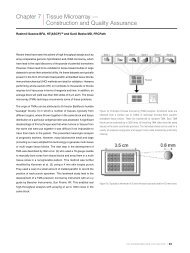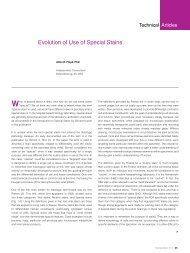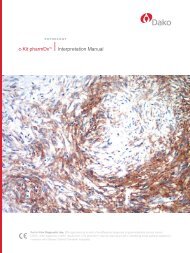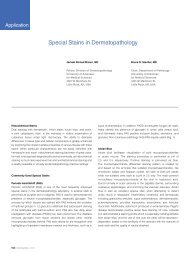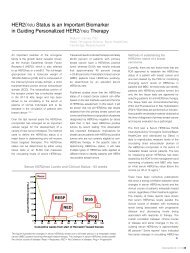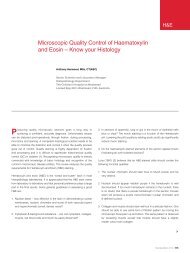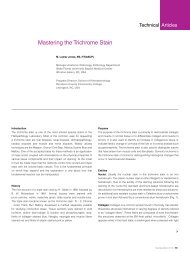Role of Special Histochemical Stains in Staining ... - Dako
Role of Special Histochemical Stains in Staining ... - Dako
Role of Special Histochemical Stains in Staining ... - Dako
You also want an ePaper? Increase the reach of your titles
YUMPU automatically turns print PDFs into web optimized ePapers that Google loves.
Silver <strong>Sta<strong>in</strong>s</strong> (Warth<strong>in</strong> Starry Sta<strong>in</strong>, Dieterle, Ste<strong>in</strong>er <strong>Sta<strong>in</strong>s</strong>)<br />
Utility <strong>of</strong> the <strong>Sta<strong>in</strong>s</strong>: Silver sta<strong>in</strong>s are very sensitive for the sta<strong>in</strong><strong>in</strong>g <strong>of</strong><br />
bacteria and therefore most useful for bacteria which do not sta<strong>in</strong> or<br />
sta<strong>in</strong> weakly with the Grams and Giemsa sta<strong>in</strong>s. Although they can be<br />
used to sta<strong>in</strong> almost any bacteria, they are tricky to perform and are<br />
therefore reserved for visualiz<strong>in</strong>g spirochetes, legionella, bartonella<br />
and H. pylori.<br />
Pr<strong>in</strong>ciples <strong>of</strong> Sta<strong>in</strong><strong>in</strong>g: Spirochetes and other bacteria can b<strong>in</strong>d<br />
silver ions from solution but cannot reduce the bound silver. The slide<br />
is first <strong>in</strong>cubated <strong>in</strong> a silver nitrate solution for half an hour and then<br />
“developed” with hydroqu<strong>in</strong>one which reduces the bound silver to a<br />
visible metallic form. The bacteria sta<strong>in</strong> dark-brown to black while the<br />
background is yellow (Fig. 6).<br />
Auram<strong>in</strong>e O- Rhodam<strong>in</strong>e B Sta<strong>in</strong><br />
The auram<strong>in</strong>e O-rhodam<strong>in</strong>e B sta<strong>in</strong> is highly specific and sensitive for<br />
mycobateria. It also sta<strong>in</strong>s dead and dy<strong>in</strong>g bacteria not sta<strong>in</strong>ed by the<br />
acid-fast sta<strong>in</strong>s. The mycobacteria take up the dye and show a reddishyellow<br />
fluorescence when exam<strong>in</strong>ed under a fluorescence microscope.<br />
Summary<br />
<strong>Histochemical</strong> sta<strong>in</strong>s available for demonstrat<strong>in</strong>g microorganisms<br />
<strong>in</strong>clude Giemsa sta<strong>in</strong>, Grams sta<strong>in</strong>, carbol fusch<strong>in</strong> acid-alcohol sta<strong>in</strong><br />
and a variety <strong>of</strong> silver sta<strong>in</strong>s such as Warth<strong>in</strong>-Starry, Dieterle and Ste<strong>in</strong>er<br />
sta<strong>in</strong>s. The Gram sta<strong>in</strong> allows classification <strong>of</strong> bacteria <strong>in</strong>to Grampositive<br />
and Gram-negative bacteria. The acid-alcohol sta<strong>in</strong> allows<br />
classification <strong>of</strong> bacilli <strong>in</strong>to acid-fast and non-acid-fast bacilli. These are<br />
both cl<strong>in</strong>ically useful classifications. The silver sta<strong>in</strong>s are very sensitive<br />
and help to visualize difficult-to-sta<strong>in</strong> bacteria. Most protozoans are<br />
sta<strong>in</strong>ed by the Giemsa sta<strong>in</strong>.<br />
Glossary<br />
Bacteria are unicellular organisms that do not conta<strong>in</strong> a nucleus or other membrane-bound<br />
organelles. Most bacteria have a rigid cell wall composed <strong>of</strong> peptidoglycan. Although there<br />
are exceptions, bacteria come <strong>in</strong> 3 basic shapes: round (cocci), rod-like (bacilli) and spiral<br />
(spirochetes). Bacteria cause a variety <strong>of</strong> <strong>in</strong>fections <strong>in</strong> various organs.<br />
Bartonella is a Gram-negative bacillus which causes cat-scratch disease. The bacilli are<br />
transmitted to humans by cat-bite or cat-scratch.<br />
Chlamydia are Gram-negative bacteria which are unusual because they do not have typical<br />
bacterial cell walls. They are obligate <strong>in</strong>tracellular parasites which means that they can<br />
only survive with<strong>in</strong> cells. Chlamydia cause sexually transmitted diseases and pneumonia<br />
<strong>in</strong> humans.<br />
Helicobacter pylori is a Gram-negative bacteria which causes <strong>in</strong>flammation (gastritis) and<br />
ulcers <strong>of</strong> the stomach. The name derives from the Greek “helix” for spiral and “pylorus” for<br />
the distal end <strong>of</strong> the stomach.<br />
Legionella is a Gram-negative bacillus so named because it caused an outbreak <strong>of</strong><br />
pneumonia <strong>in</strong> people attend<strong>in</strong>g a 1976 convention <strong>of</strong> the American Legion <strong>in</strong> Philadelphia.<br />
The organism was unknown till then and was subsequently named Legionella. It causes<br />
pneumonia.<br />
Mycobacteria are bacilli that have a thick and waxy (Lat<strong>in</strong>, myco = wax) cell wall composed<br />
<strong>of</strong> a lipid called mycolic acid. This cell wall is responsible for the hard<strong>in</strong>ess <strong>of</strong> this organism<br />
as well as for its sta<strong>in</strong><strong>in</strong>g characteristics. The waxy cell wall is hydrophobic and resists<br />
sta<strong>in</strong><strong>in</strong>g with aqueous sta<strong>in</strong>s like the Gram and Giemsa sta<strong>in</strong>s. It also resists decolorisation<br />
once sta<strong>in</strong>ed. Mycobacteria causes tuberculosis, leprosy and <strong>in</strong>fections <strong>in</strong> patients<br />
with AIDS.<br />
Protozoa (Greek, proton = first; zoa = animal) are unicellular organisms that have a<br />
membrane-bound nucleus and other complex membrane-bound organelles.<br />
Rickettsia are Gram-negative bacteria that like Chlamydia lack typical cell walls and are<br />
obligate <strong>in</strong>tracellular parasites. The rickettsial diseases are primary diseases <strong>of</strong> animals<br />
(zoonosis) such as the deer which are transmitted to humans by bites <strong>of</strong> <strong>in</strong>sects like fleas<br />
and ticks. Rickettsial diseases <strong>in</strong>clude typhus fever and Rocky Mounta<strong>in</strong> Spotty Fever.<br />
Spirochetes are long Gram-negative bacilli with tightly-coiled helical shapes. Spirochetes<br />
cause syphilis, leptospirosis and Lyme’s disease.<br />
Connection 2010 | 91



